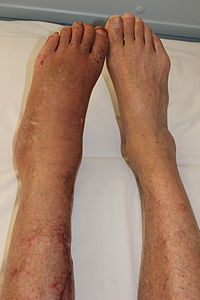
Photo from wikipedia
BACKGROUND Phantom limb pain (PLP) is a common problem after limb amputation. There is mounting evidence supporting the use of mirror therapy (MT) in the treatment of individuals with PLP.… Click to show full abstract
BACKGROUND Phantom limb pain (PLP) is a common problem after limb amputation. There is mounting evidence supporting the use of mirror therapy (MT) in the treatment of individuals with PLP. However, there is no research studying the effects of MT on PLP in individuals with intellectual developmental disorders (IDD). The aim of this study was to increase our understanding of MT when used with adults with IDD and PLP through a case study approach. METHODS Here, we describe the use of MT with a 53-year-old female with moderate IDD and PLP, related to her left leg being amputated after ulcer complications. The study followed an A-B-A-B design (baseline - treatment - withdrawal of treatment - re-introduction of treatment), lasting two years, which included a long-term follow-up. RESULTS The data showed that the PLP sensation decreased after the MT treatment, with a raw change of 3.92 points and a 48% decrease in mean pain intensity ratings from pre- to post-treatment. CONCLUSIONS This is a unique case-report on the use of MT with an individual with IDD suffering from PLP. The findings show that MT helped to significantly reduce the intensity of the PLP in this patient.
Journal Title: European journal of pain
Year Published: 2021
Link to full text (if available)
Share on Social Media: Sign Up to like & get
recommendations!